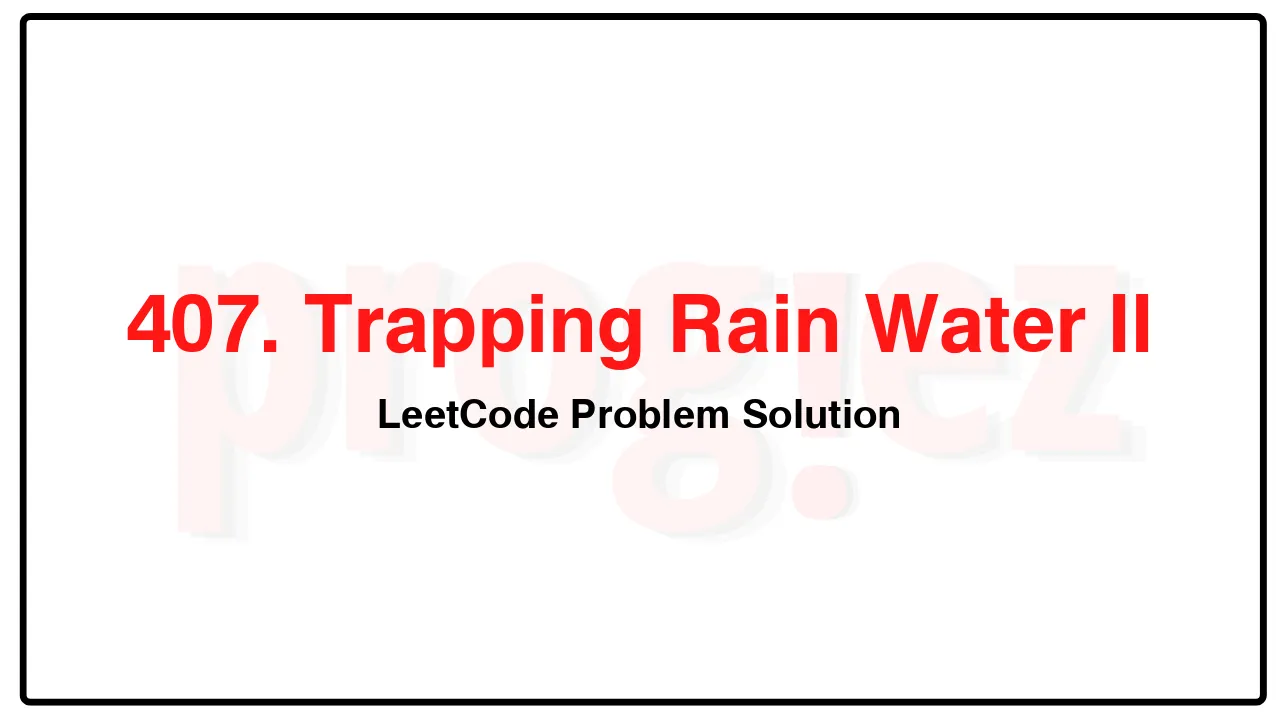407. Trapping Rain Water II LeetCode Solution
In this guide, you will get 407. Trapping Rain Water II LeetCode Solution with the best time and space complexity. The solution to Trapping Rain Water II problem is provided in various programming languages like C++, Java, and Python. This will be helpful for you if you are preparing for placements, hackathons, interviews, or practice purposes. The solutions provided here are very easy to follow and include detailed explanations.
Table of Contents
- Problem Statement
- Complexity Analysis
- Trapping Rain Water II solution in C++
- Trapping Rain Water II solution in Java
- Trapping Rain Water II solution in Python
- Additional Resources

Problem Statement of Trapping Rain Water II
Given an m x n integer matrix heightMap representing the height of each unit cell in a 2D elevation map, return the volume of water it can trap after raining.
Example 1:
Input: heightMap = [[1,4,3,1,3,2],[3,2,1,3,2,4],[2,3,3,2,3,1]]
Output: 4
Explanation: After the rain, water is trapped between the blocks.
We have two small ponds 1 and 3 units trapped.
The total volume of water trapped is 4.
Example 2:
Input: heightMap = [[3,3,3,3,3],[3,2,2,2,3],[3,2,1,2,3],[3,2,2,2,3],[3,3,3,3,3]]
Output: 10
Constraints:
m == heightMap.length
n == heightMap[i].length
1 <= m, n <= 200
0 <= heightMap[i][j] <= 2 * 104
Complexity Analysis
- Time Complexity: O(mn\log mn)
- Space Complexity: O(mn)
407. Trapping Rain Water II LeetCode Solution in C++
struct T {
int i;
int j;
int h; // heightMap[i][j] or the height after filling water
};
class Solution {
public:
int trapRainWater(vector<vector<int>>& heightMap) {
constexpr int dirs[4][2] = {{0, 1}, {1, 0}, {0, -1}, {-1, 0}};
const int m = heightMap.size();
const int n = heightMap[0].size();
int ans = 0;
auto compare = [](const T& a, const T& b) { return a.h > b.h; };
priority_queue<T, vector<T>, decltype(compare)> minHeap(compare);
vector<vector<bool>> seen(m, vector<bool>(n));
for (int i = 0; i < m; ++i) {
minHeap.emplace(i, 0, heightMap[i][0]);
minHeap.emplace(i, n - 1, heightMap[i][n - 1]);
seen[i][0] = true;
seen[i][n - 1] = true;
}
for (int j = 1; j < n - 1; ++j) {
minHeap.emplace(0, j, heightMap[0][j]);
minHeap.emplace(m - 1, j, heightMap[m - 1][j]);
seen[0][j] = true;
seen[m - 1][j] = true;
}
while (!minHeap.empty()) {
const auto [i, j, h] = minHeap.top();
minHeap.pop();
for (const auto& [dx, dy] : dirs) {
const int x = i + dx;
const int y = j + dy;
if (x < 0 || x == m || y < 0 || y == n)
continue;
if (seen[x][y])
continue;
if (heightMap[x][y] < h) {
ans += h - heightMap[x][y];
minHeap.emplace(x, y, h); // Fill water in grid[x][y].
} else {
minHeap.emplace(x, y, heightMap[x][y]);
}
seen[x][y] = true;
}
}
return ans;
}
};
/* code provided by PROGIEZ */407. Trapping Rain Water II LeetCode Solution in Java
class T {
public int i;
public int j;
public int h; // heightMap[i][j] or the height after filling water
public T(int i, int j, int h) {
this.i = i;
this.j = j;
this.h = h;
}
}
class Solution {
public int trapRainWater(int[][] heightMap) {
final int[][] dirs = {{0, 1}, {1, 0}, {0, -1}, {-1, 0}};
final int m = heightMap.length;
final int n = heightMap[0].length;
int ans = 0;
Queue<T> minHeap = new PriorityQueue<>((a, b) -> Integer.compare(a.h, b.h));
boolean[][] seen = new boolean[m][n];
for (int i = 0; i < m; ++i) {
minHeap.offer(new T(i, 0, heightMap[i][0]));
minHeap.offer(new T(i, n - 1, heightMap[i][n - 1]));
seen[i][0] = true;
seen[i][n - 1] = true;
}
for (int j = 1; j < n - 1; ++j) {
minHeap.offer(new T(0, j, heightMap[0][j]));
minHeap.offer(new T(m - 1, j, heightMap[m - 1][j]));
seen[0][j] = true;
seen[m - 1][j] = true;
}
while (!minHeap.isEmpty()) {
final int i = minHeap.peek().i;
final int j = minHeap.peek().j;
final int h = minHeap.poll().h;
for (int[] dir : dirs) {
final int x = i + dir[0];
final int y = j + dir[1];
if (x < 0 || x == m || y < 0 || y == n)
continue;
if (seen[x][y])
continue;
if (heightMap[x][y] < h) {
ans += h - heightMap[x][y];
minHeap.offer(new T(x, y, h)); // Fill water in grid[x][y].
} else {
minHeap.offer(new T(x, y, heightMap[x][y]));
}
seen[x][y] = true;
}
}
return ans;
}
}
// code provided by PROGIEZ407. Trapping Rain Water II LeetCode Solution in Python
class Solution:
def trapRainWater(self, heightMap: list[list[int]]) -> int:
dirs = ((0, 1), (1, 0), (0, -1), (-1, 0))
m = len(heightMap)
n = len(heightMap[0])
ans = 0
minHeap = []
seen = set()
for i in range(m):
heapq.heappush(minHeap, (heightMap[i][0], i, 0))
heapq.heappush(minHeap, (heightMap[i][n - 1], i, n - 1))
seen.add((i, 0))
seen.add((i, n - 1))
for j in range(1, n - 1):
heapq.heappush(minHeap, (heightMap[0][j], 0, j))
heapq.heappush(minHeap, (heightMap[m - 1][j], m - 1, j))
seen.add((0, j))
seen.add((m - 1, j))
while minHeap:
h, i, j = heapq.heappop(minHeap)
for dx, dy in dirs:
x = i + dx
y = j + dy
if x < 0 or x == m or y < 0 or y == n:
continue
if (x, y) in seen:
continue
if heightMap[x][y] < h:
ans += h - heightMap[x][y]
# Fill water in grid[x][y].
heapq.heappush(minHeap, (h, x, y))
else:
heapq.heappush(minHeap, (heightMap[x][y], x, y))
seen.add((x, y))
return ans
# code by PROGIEZAdditional Resources
- Explore all LeetCode problem solutions at Progiez here
- Explore all problems on LeetCode website here
Happy Coding! Keep following PROGIEZ for more updates and solutions.









